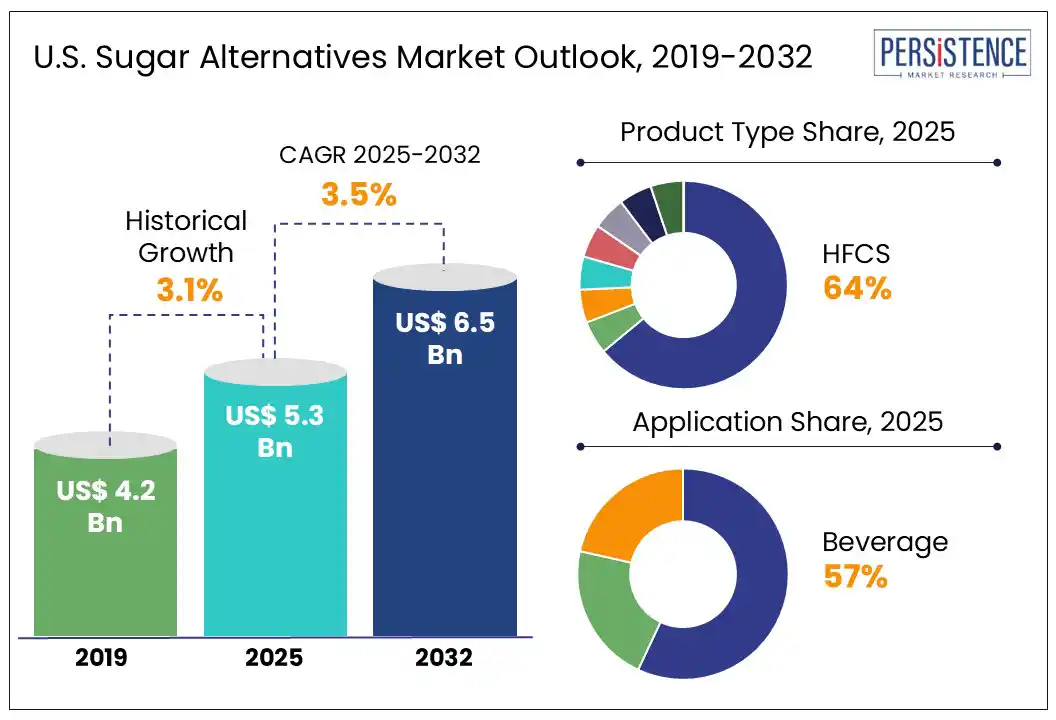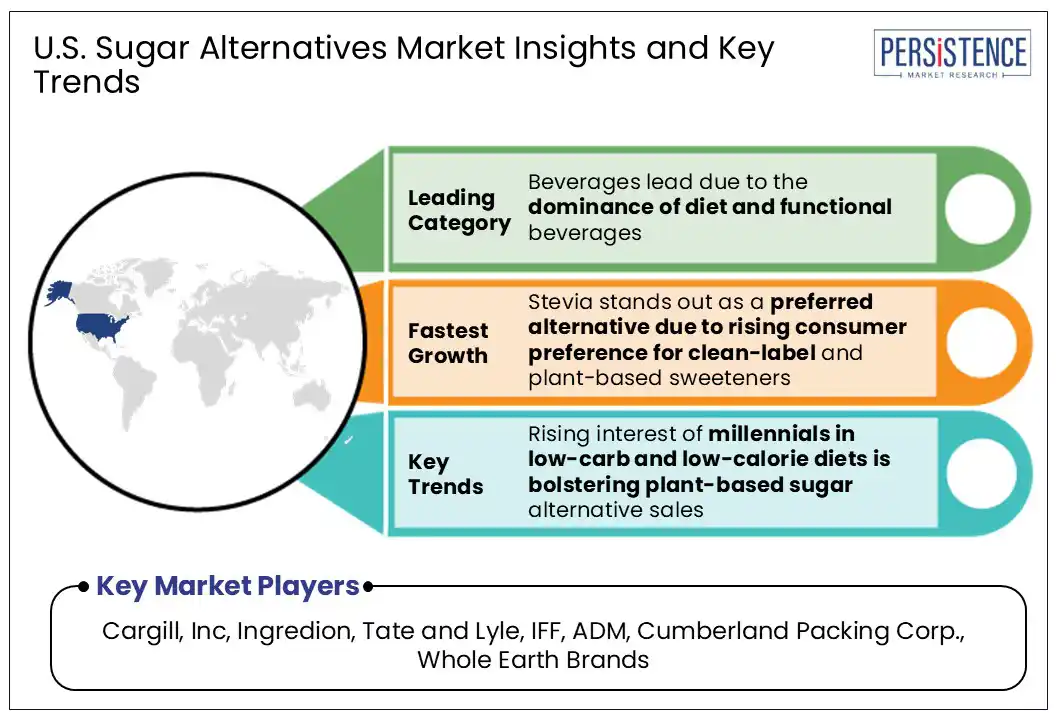ID: PMRREP34906| 192 Pages | 15 Jul 2025 | Format: PDF, Excel, PPT* | Food and Beverages

The U.S. Sugar Alternatives market size is likely to be valued at US$ 5.1 billion in 2025 and is estimated to reach US$ 6.5 billion by 2032, growing at a CAGR of 3.5% during the forecast period 2025 to 2032. The U.S. sugar alternatives market is entering a transformative phase, driven by clean-label demand, diabetic population growth, and regulatory pressure on added sugars. Innovation in plant-based sweeteners and flavor-masking technologies is redefining product formulation strategies, positioning the U.S. as a global leader in sugar reduction solutions.

Key Industry Highlights
|
U.S. Market Attributes |
Key Insights |
|
U.S. Sugar Alternatives Market Size (2025E) |
US$ 5.1 Bn |
|
Market Value Forecast (2032F) |
US$ 6.5 Bn |
|
Projected Growth (CAGR 2025 to 2032) |
3.5% |
|
Historical Market Growth (CAGR 2019 to 2024) |
3.1% |
In the U.S. sugar alternatives market, the increasing prevalence of diabetes and prediabetes is reshaping consumer dietary behavior. According to the Centers for Disease Control and Prevention (CDC), over 37 million Americans have diabetes, while an alarming 97.6 million adults are classified as prediabetic. This has created a vast consumer base actively seeking healthier alternatives to traditional sugar. As awareness of excessive sugar intake and chronic metabolic conditions increases, consumers are turning to sugar substitutes that deliver sweetness without adverse health effects.
Non-nutritive sweeteners such as saccharin and aspartame are widely adopted for their low-calorie and low-glycemic properties, often regarded as "free foods" for diabetics. Health advocacy campaigns and labeling transparency have further accelerated this shift. As the U.S. population grapples with diet-related health concerns, sugar alternatives are becoming essential components of preventive nutrition and chronic disease management, rather than just niche wellness products.
A primary restraint for the U.S. sugar alternatives market is consumers' strong association of sugar with a complete sensory experience, encompassing sweetness, texture, flavor enhancement, and overall satisfaction. Many sugar substitutes, particularly artificial sweeteners like aspartame and sucralose, fall short in replicating this multifaceted profile, often leaving undesirable aftertastes. Natural alternatives, such as stevia, can also impart off-notes, like a licorice-like flavor. This inability to fully mimic sugar's organoleptic qualities restricts their application, especially in products where texture and mouthfeel are crucial, such as baked goods and sauces. Furthermore, persistent consumer skepticism regarding artificial sweeteners' long-term health implications further hinders adoption. Manufacturers thus face an ongoing challenge to innovate formulations that accurately replicate sugar's taste and texture, a significant hurdle impacting market growth.
The U.S. sugar alternatives market presents a significant opportunity for companies to engage in collaborative partnerships to innovate and co-develop products that incorporate sugar substitutes. A prime example of this trend is Ajinomoto’s partnership with Shiru in August 2024. Through its subsidiary, Ajinomoto Health & Nutrition North America (AHN), the company sought to leverage Shiru's AI-driven protein discovery capabilities alongside its fermentation expertise to create sweet proteins for beverages and specialty products. This collaboration is focused on developing natural sweeteners that mimic the taste of sugar while being derived from fruits and berries found near the equator, aligning with the rise in consumer preference for natural and minimally processed ingredients.
Such partnerships allow companies to combine their strengths, enhance product offerings, and address the demand for healthier alternatives to traditional sugars. By working together, businesses can accelerate the development of innovative sweetening solutions that not only meet taste expectations but also align with consumer desires for transparency and sustainability in food sourcing. This collaborative approach can significantly broaden market reach, attract health-conscious consumers, and foster the introduction of unique products that stand out in a competitive landscape.
Stevia is expected to grow at a leading CAGR during the forecast period from 2025 to 2032. As health consciousness grows, consumers are actively moving away from traditional sugars, often linked to prevalent diseases like diabetes and obesity. Stevia, derived from the leaves of the Stevia rebaudiana plant, offers a compelling calorie-free substitute that aligns perfectly with the desire for reduced caloric intake without sacrificing sweetness. Its perception as a healthier, natural option compared to artificial sweeteners is further bolstered by the burgeoning clean-eating movement, where consumers prioritize products with recognizable and minimally processed ingredients.
Being marketed as a plant-based sweetener positions stevia favorably with the increasing number of consumers adopting vegan and plant-focused diets. Furthermore, continuous advancements in extraction and formulation technologies have significantly mitigated the historical challenge of stevia's bitter aftertaste, leading to a much-improved sensory profile that closely mimics sugar's sweetness.
The beverages sector dominates the application segment, holding approximately 57% market share in 2024. This is primarily due to consumer demand for reduced-calorie and health-forward drink options, which propels the use of sweeteners like stevia, monk fruit, and allulose. These alternatives offer sweetness without contributing to calorie intake or glycemic spikes, making them ideal for soft drinks, flavored waters, teas, and even ready-to-drink alcoholic beverages. Established brands are reformulating existing products, while newer entrants are launching clean-label, plant-based formulations to meet rising health expectations.
For instance, Suntory Holdings Ltd. has introduced functional beverages that combine high-intensity sweeteners with amino acids to enhance sweetness perception and eliminate aftertaste, solving a long-standing sensory challenge. Additionally, the clean-eating and wellness movement supports this trend, as consumers increasingly demand transparent ingredients. Technological advances in taste-masking and ingredient synergies are further enhancing flavor profiles. As a result, the beverage category is leading application-based growth, with sugar alternatives becoming central to innovation pipelines and reshaping the competitive landscape.

The U.S. sugar alternatives market is rapidly evolving, driven by consumer demand for healthier dietary choices and regulatory pressures to reduce sugar consumption. Manufacturers are investing in advanced sweetener formulations, extraction techniques, and clean-label ingredients to deliver low- or no-calorie alternatives that meet evolving consumer preferences. U.S. brands are adopting holistic product development strategies such as ADM’s full-spectrum ingredient toolbox that blends natural sweeteners with functional additives to improve taste, texture, and nutritional value. The competitive landscape is intensifying, as companies such as Ingredion leverage life cycle assessments to highlight the benefits of advanced stevia variants like Reb M.
Meanwhile, the U.S. regulatory environment, overseen by the FDA, plays a crucial role in shaping market dynamics. GRAS classification and food additive regulations present both opportunities and hurdles for innovation. Additionally, revised nutrition labeling requirements are driving greater transparency, prompting companies to reformulate and communicate sugar content and substitutes. In response, players are refining marketing strategies to maintain compliance while building trust, positioning the U.S. as a leading market for sugar-reduction innovation and consumer-driven reformulations.
The U.S. Sugar Alternatives market is projected to be valued at US$ 5.1 Bn in 2025.
The growing prevalence of diabetes is fueling demand for the U.S. Sugar Alternatives market.
The U.S. Sugar Alternatives market is poised to witness a CAGR of 3.5% between 2025 and 2032.
Collaborative partnerships offer a key opportunity to co-develop products with sugar alternatives.
Major players in the U.S. Sugar Alternatives market include Cargill, Inc, Ingredion, Tate and Lyle, IFF, ADM, Cumberland Packing Corp., Whole Earth Brands, and others.
|
Report Attribute |
Details |
|
Historical Data/Actuals |
2019 - 2024 |
|
Forecast Period |
2025 - 2032 |
|
Market Analysis |
Value: US$ Bn, Volume: Kilo Tons |
|
Region Coverage |
|
|
Segmental Coverage |
|
|
Competitive Analysis |
|
|
Report Highlights |
|
|
Customization and Pricing |
Available upon request |
By Product Type
By Intensity
By Application
By Distribution Channel
By Region
Delivery Timelines
For more information on this report and its delivery timelines please get in touch with our sales team.
About Author